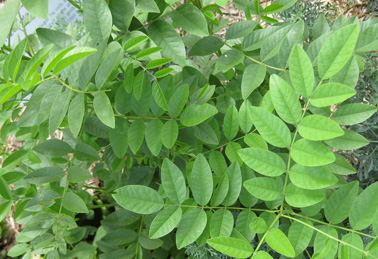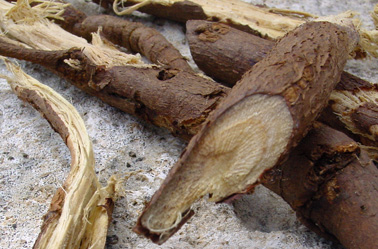|
Botanical Name:
Glycyrrhiza glabra Linn
Jeshtimadh consists of dried, unpeeled, stolon and root of
Glycyrrhiza glabra Linn, Family Leguminosae
Common Name(s) in English & Indian Languages
Sanskrit: Yastimadhuka, Yastika, Madhuka, Madhuyasti,
Yastyahva
Assamese: Jesthimadhu, Yeshtmadhu
Bengali: Yashtimadhu
English: Liquorice root
Guajarati: Jethimadha, Jethimard, Jethimadh
Hindi: Mulethi, Mulathi, Muleti, Jethimadhu, Jethimadh
Kannada: Jestamadu, Madhuka, Jyeshtamadhu, Atimadhura
Kashmiri: Multhi
Malayalam: Irattimadhuram
Marathi: Jesthamadh
Oriya: Jatimadhu, Jastimadhu
Punjabi: Jethimadh, Mulathi
Tamil: Athimadhuram
Telugu: Atimadhuramu
Urdu: Mulethi, Asl-us-sus
Botanical description:
A perennial plant, up to more than 1m in height, erect, with
highly developed stoloniferous roots. Leaves compound, 9–17
alternate imparipinnate leaflets, oblong to elliptical-lanceolate,
acute or obtuse; racemes loose, shorter than the leaves or a
little longer. Flowers 1 cm long. Flat pods oblong to
linear, 1–3cm long by 6 mm wide, more or less densely
echinate glandular, many-seeded or abbreviated, 2- or
3-seeded.
Parts used:
Dried stem & roots
Major chemical constituent
Glycyrrhizin, glycyrrhizic acid, glycyrrhetinic acid,
asparagine, sugars, resin and starch
Therapeutic uses:
• Cough (Kasa)
• Pthisis (Ksaya)
• Hoarseness of voice (Svarabheda)
• Gout (Vatarakta)
• Ulcer (Vrana) |
|


|
|
|



